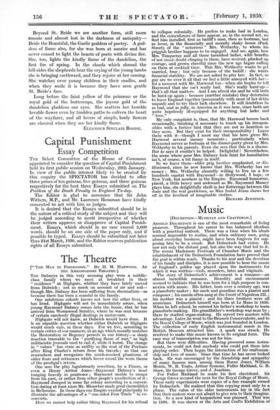St. Bride of the Kindly Flame
FEBRUARY is the month of St. Bride of the Kindly Flame, St. Bride the gentle mother of all young and tender things. Through the mists of centuries we see her gracious figure, her lamb in her arms, a lamp in her hand. When the bitter winds are still blowing, the kindly flame of her flower, the dandelion, shines out and tells us that spring is near. Gentle. St. Bride is spring's har- binger, the patron saint of the first flowers and young children. She watches over mothers and their new-born babes and on the hill-sides she brings the shepherds to the new-born lambs. She is loved in all Celtic lands, from the western highlands and islands of Scotland to Kildare, where, for centuries, her lamp was kept always burning.
St. Bride's father was Dubtach, twelfth in descent from Fcdlimidh Rechtmar, King of Ireland in the second century. Her mother was a beautiful slave. When St. Bride took the veil seven virgins followed her example, and each of them chose a Beatitude representing the grace she specially desired. St. Bride chose " Blessed are the merciful for they shall obtain mercy." The various lives of her recount many tales of her gentle pity for all young creatures, and for weak and suffering folk. She was noted for her love of animals and birds, and she particularly delighted in calling the wild duck and geese to her and caressing them.
When her fame was at its height Iollan King of Leinster offered her land to build a monastery. She chose the clay ridge above the plain of Magh Breagh and there, by an ancient and venerated oak she established her ei//, afterwards famous as Kildare, the " cell of the oak." Innumerable folk of both sexes came to her till and, according to Cogitosus, Kildare became " the head of nearly all the Irish churches and the pinnacle towering above all monasteries of the Scots, whose jurisdiction spread throughout the whole Hibernian land reaching from sea to sea." St. Bride was joined by her kinsman Conlaeth, a hermit who was famed for the bells he made. He became bishop " to govern the church with her in episcopal dignity." Even when he was a bishop Con- laeth continued to work at his anvil, and made many croziers and. bells. Whether St. Bride loved bells we do not know, but it is on record that St. Gildas sent her a bell from Brittany. Numerous churches are named after this beloved saint, amongst others St. Bride in Fleet Street. Beyond St. Bride we see another form, still more remote and almost lost in the darkness of antiquity— Bride the Beautiful, the Gaelic goddess of poetry. A god- dess of flame also, for she was born at sunrise and has never ceased to light the hearts of poets with divine fire. She, too, lights the kindly flame of the dandelion, the first fire of spring. In the clouds which shroud the hill-sides the shepherds hear the crying of the young lambs she is bringing earthward, and they rejoice at her coming. She watches over young children in their cradles, and when they smile it is because they have seen gentle St. Bride's face.
Long before the faint yellow of the primrose or the royal gold of 'the. buttercups, the joyous gold of the dandelion gladdens our eyes. She scatters her humble lovable flower even by trodden paths to enliven the heart of the wayfarer, and all lovers of simple, lowly flowers are cheered when they see her kindly flame.
ELEANOUR SINCLAIR ROIIDE.







































 Previous page
Previous page